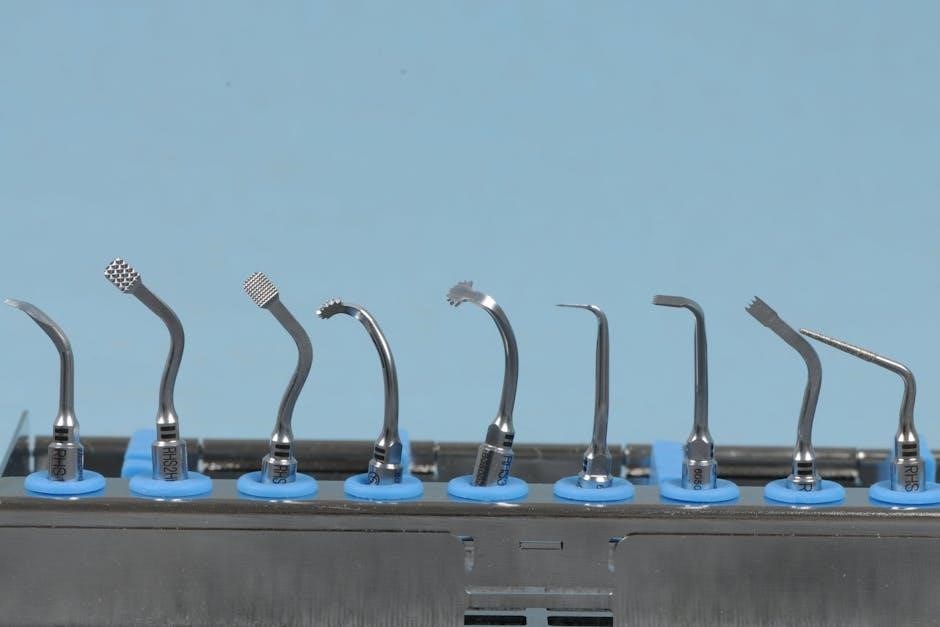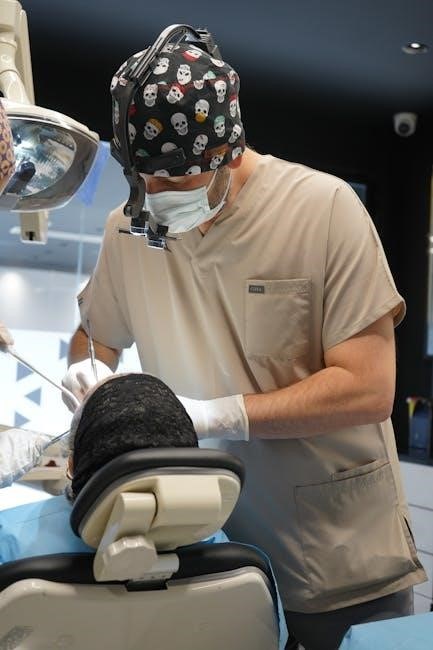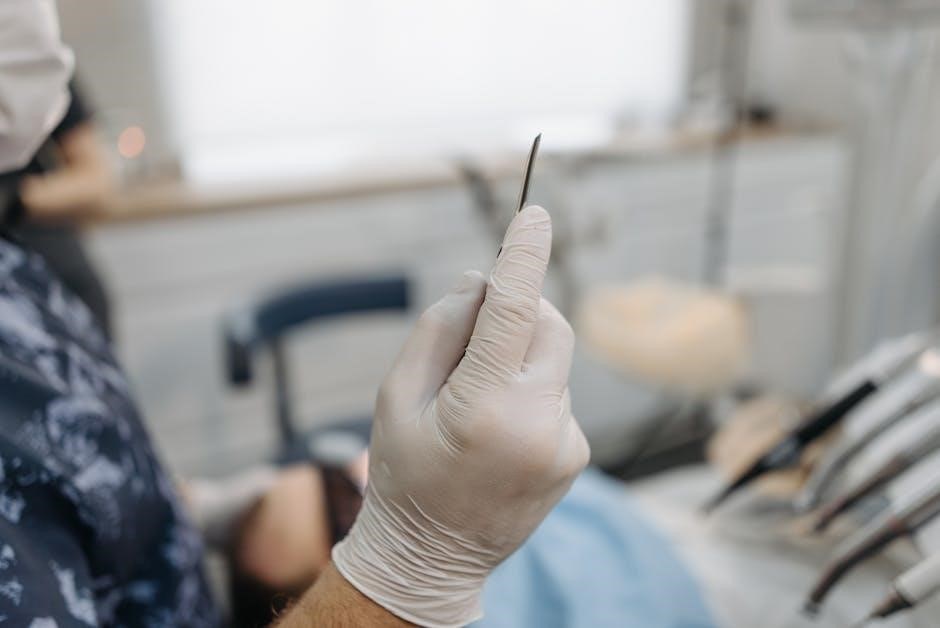
Surgical guides are essential tools in modern dentistry, enhancing precision and efficiency in implant placement. They are fabricated using CDT code D6190, ensuring accurate implant positioning and minimizing complications.
1.1 Importance of Surgical Guides in Dental Implantology
Surgical guides play a pivotal role in dental implantology by ensuring precise placement of dental implants. They enhance accuracy, reduce surgical complications, and improve patient outcomes. The use of these guides, coded under CDT D6190, streamlines the implantation process, minimizing errors and optimizing results; By providing a clear roadmap for implant placement, surgical guides help clinicians achieve predictable outcomes, making them indispensable in modern dental practices. Their importance lies in their ability to merge diagnostic data with surgical execution, ensuring efficient and successful implant procedures. This tool is fundamental for both clinicians and patients, fostering confidence and reliability in implantology treatments.
1.2 Overview of the Dental Code System
The dental code system, maintained by the American Dental Association (ADA), provides standardized codes for dental procedures. These codes, like CDT D6190, ensure consistency in billing, insurance claims, and documentation. The system categorizes procedures, making communication between dental professionals and insurers clear. Regular updates, such as the 2025 CDT code changes, reflect advancements in dental care. This structured approach simplifies tracking and reimbursement, benefiting both clinicians and patients. The dental code system is essential for efficient practice management and accurate reporting of dental services;

Understanding the CDT Code System
The CDT code system, developed by the ADA, standardizes dental procedures for billing and documentation. It includes codes like D6190, which specifies surgical guide fabrication, ensuring clarity and consistency in dental care practices.
2.1 What is the CDT Code D6190?
CDT code D6190 refers to the “Radiographic/Surgical Implant Index,” a procedure for creating a guide to document implant locations relative to neighboring teeth. It aids in precise implant placement, ensuring accurate positioning and alignment. This code is crucial for both digital and traditional surgical guides, covering various types, including fully or partially guided and single or multiple units. D6190 is used by dental professionals to streamline implant procedures, improving efficiency and reducing complications. It is a key component in modern implantology, facilitating effective treatment planning and execution.
2.2 Significance of D6190 in Surgical Guide Fabrication
CDT code D6190 plays a pivotal role in surgical guide fabrication by ensuring precise implant placement. It facilitates the creation of a radiographic or surgical index, which guides the accurate positioning of dental implants. This code is integral for capturing the spatial relationship between implants and surrounding teeth, reducing errors and complications. By standardizing the fabrication process, D6190 enhances surgical efficiency and patient outcomes. It is essential for both digital and traditional guides, supporting various types such as fully or partially guided systems. The use of D6190 streamlines pre-surgical planning, ensuring optimal results and minimizing treatment time, ultimately improving patient satisfaction and procedural success.

Types of Surgical Guides
Surgical guides vary, including digital and traditional options, fully or partially guided systems, and single or multiple unit designs, each tailored for specific implant placement needs.
3.1 Digital vs. Traditional Surgical Guides
Digital surgical guides, fabricated using CAD/CAM technology, offer enhanced precision and customization, reducing surgical time and complications. Traditional guides, handmade from dental models, are cost-effective and simple to use.
3.2 Fully Guided vs. Partially Guided Surgical Guides
Fully guided surgical guides provide comprehensive direction for every aspect of implant placement, ensuring precise positioning and alignment. Partially guided options offer directional support for specific areas, allowing flexibility during procedures. Fully guided systems, often fabricated using digital technologies, minimize human error and are ideal for complex cases. Partially guided guides, while less precise, are useful in simpler scenarios or when anatomical adaptability is needed. Both types are classified under CDT code D6190, reflecting their role in enhancing surgical accuracy and efficiency in dental implantology.
3.3 Single vs. Multiple Unit Surgical Guides
Single-unit surgical guides are designed for precise placement of individual dental implants, offering high accuracy in straightforward cases. Multiple-unit guides, however, accommodate several implants, ideal for full-mouth reconstructions or complex cases. Single-unit guides are typically simpler in fabrication, while multiple-unit guides require detailed planning to ensure proper alignment and distribution of implants. Both types are categorized under CDT code D6190, emphasizing their role in enhancing surgical precision. The choice between them depends on the patient’s needs, anatomical constraints, and the complexity of the procedure, ensuring optimal outcomes in dental implantology.
3.4 Custom vs. Stock Surgical Guides
Custom surgical guides are tailored to individual patient anatomy, offering precise implant placement and enhanced accuracy. Fabricated using digital data, they are ideal for complex cases. Stock guides, however, are pre-fabricated and less expensive, suitable for straightforward procedures. Custom guides ensure optimal fit and alignment, reducing surgical time and complications, while stock guides provide a cost-effective solution for simpler cases. Both types are classified under CDT code D6190, highlighting their importance in implantology. The choice between custom and stock guides depends on the patient’s specific needs and the complexity of the procedure, ensuring the best possible outcomes in dental implant placement.
Fabrication and Placement of Surgical Guides
Surgical guides are fabricated using digital or traditional methods, tailored to patient anatomy. Placement involves precise alignment with the patient’s jaw, ensuring accurate implant positioning and optimal outcomes.
4.1 Fabrication Process of Surgical Guides
The fabrication of surgical guides involves precise planning and technology. Digital methods use CAD/CAM systems and 3D printing to create guides from CT scans or intraoral scans. Traditional methods rely on stone models and wax or acrylic materials. Both processes aim to replicate the patient’s anatomy accurately. Guides are designed to fit snugly over teeth or bone, ensuring stability during surgery. Materials like 3D-printed resin or sterilizable plastics are commonly used. The process includes data collection, design, and final production, with quality checks to ensure accuracy. These guides are indispensable for achieving precise implant placement and minimizing surgical complications.
4.2 Placement Techniques for Surgical Guides
The placement of surgical guides requires meticulous technique to ensure accuracy and stability. Guides are typically secured over the teeth or bone, using retention screws or friction fit. For fully guided surgeries, the guide remains in place throughout the procedure, while partially guided techniques allow for adjustments. Advanced systems may incorporate 3D imaging for real-time tracking. Proper alignment and fixation are critical to prevent movement during drilling or implant placement. Surgeons often use specialized tools to ensure the guide stays stable, minimizing errors. The goal is to achieve precise implant positioning while maintaining patient comfort and safety. Sterility and precise handling are paramount.

Benefits and Clinical Applications
Surgical guides enhance accuracy, efficiency, and patient comfort in implant procedures. They minimize complications, reduce recovery time, and optimize outcomes, making them a cost-effective solution.
5.1 Enhanced Accuracy in Implant Placement
Surgical guides significantly improve the precision of dental implant placement by providing a clear, pre-planned trajectory. They ensure optimal positioning, angle, and depth, reducing human error. This accuracy minimizes complications, such as nerve damage or improper fit, and enhances aesthetic outcomes. The use of CDT code D6190 for these guides streamlines the process, allowing for precise documentation and insurance coverage. By transferring digital plans to the surgical site, guides ensure implants are placed exactly as intended, improving overall success rates and patient satisfaction. This level of precision is critical for achieving functional and esthetic results in modern implantology.
5.2 Improved Surgical Efficiency
Surgical guides significantly enhance surgical efficiency by providing a pre-planned, precise framework for implant placement. This reduces the time spent intraoperatively, as the guide directs the exact location, angle, and depth of each implant. The use of CDT code D6190 ensures that the fabrication of these guides is standardized and reimbursable. By minimizing the need for real-time adjustments, surgical guides streamline the procedure, allowing dentists to focus on execution. This efficiency also reduces the overall duration of the surgery, improving patient comfort and recovery time. Additionally, it decreases the risk of complications, making the process more predictable and successful for both clinicians and patients.
5.3 Cost-Effectiveness of Surgical Guides
Surgical guides offer significant cost savings by reducing errors and the need for additional procedures. The use of CDT code D6190 ensures that the fabrication of these guides is a reimbursable expense, making it more accessible for patients. By streamlining the surgical process, guides minimize chair time and reduce the need for costly adjustments. Additionally, they optimize resource utilization, lowering overall treatment expenses. While the initial investment in guide fabrication is modest, the long-term benefits of precision and efficiency make surgical guides a highly cost-effective solution in modern dental implantology.
5.4 Patient Comfort and Satisfaction
Surgical guides significantly enhance patient comfort and satisfaction by minimizing invasive procedures and reducing surgery time. Their precise placement ensures fewer complications, leading to faster recovery and less post-operative discomfort. Patients appreciate the predictable outcomes, as guides improve the aesthetic and functional results of implants. The streamlined process also reduces anxiety, as the procedure is more efficient and less traumatic. Overall, the use of surgical guides creates a more positive experience, fostering trust and satisfaction in dental care. This alignment of technology and patient-centric outcomes underscores their value in modern implantology.
5.5 Reduced Complications and Recovery Time
The use of surgical guides minimizes complications by ensuring precise implant placement, reducing the risk of nerve damage or improper positioning. This accuracy lowers post-operative discomfort and accelerates healing. Patients experience shorter recovery periods due to minimized surgical trauma. Fewer complications mean less need for corrective procedures, improving overall outcomes. The CDT code D6190, associated with these guides, reflects their role in streamlining implantology, ultimately benefiting both clinicians and patients by reducing recovery time and enhancing surgical success rates.

Billing and Insurance Considerations
CDT code D6190 is used for billing surgical guides, ensuring accurate reimbursement. Insurance coverage varies, but precise coding enhances claim processing and payment for dental implant procedures.
6.1 Insurance Coverage for Surgical Guides
Insurance coverage for surgical guides varies by provider and policy. CDT code D6190 is often reimbursed when deemed medically necessary for implant placement accuracy. Some insurers cover partial costs, while others may not cover them at all, depending on the policy terms. It’s crucial for dental practices to verify coverage beforehand and ensure accurate documentation to facilitate smoother claims processing. Proper coding and justification of the surgical guide’s necessity can significantly improve reimbursement outcomes for both patients and providers.
6.2 Billing Codes and Reimbursement Process
Billing for surgical guides involves specific CDT codes, with D6190 being the primary code for radiographic or surgical implant indexes. Additional codes like D7290 (fabrication) and D6194 (placement) may apply. Reimbursement varies by insurer, with some covering these procedures under certain conditions. Accurate documentation and justification of the surgical guide’s necessity are critical for successful claims. Dental practices should verify insurance policies beforehand and ensure compliance with coding guidelines to optimize reimbursement outcomes. Proper coding and detailed reporting are essential to avoid denial of claims and ensure fair compensation for the procedure.
Surgical guides, coded under D6190, are vital for precise dental implant placement, enhancing accuracy and efficiency. Their use ensures optimal outcomes, patient satisfaction, and streamlined procedures in modern dentistry.
7.1 Summary of Key Points
Surgical guides, coded under D6190, play a pivotal role in dental implantology by ensuring precise placement and minimizing complications. They are fabricated to match patient anatomy, guiding implant positioning accurately. The code encompasses various guide types, including digital and traditional, and is essential for both single and multiple unit placements. D6190 simplifies billing and documentation, facilitating insurance reimbursement. Its use enhances surgical efficiency, patient comfort, and overall procedural outcomes, making it a cornerstone in modern dental implant practices. Understanding D6190 is crucial for effective coding and optimal patient care in contemporary dentistry.
7.2 Future Trends in Surgical Guide Technology
Future trends in surgical guide technology are expected to focus on enhanced precision and integration with digital workflows. Advances in AI-driven software and 3D printing will enable more accurate and customizable guides, reducing surgical time and improving outcomes. Real-time tracking systems and augmented reality may become integral, offering dentists greater control during procedures. The use of biocompatible materials and patient-specific designs will continue to evolve, ensuring optimal fit and functionality. As technology progresses, the CDT code system, including D6190, will likely expand to accommodate new innovations, ensuring seamless billing and documentation for cutting-edge surgical guide applications.